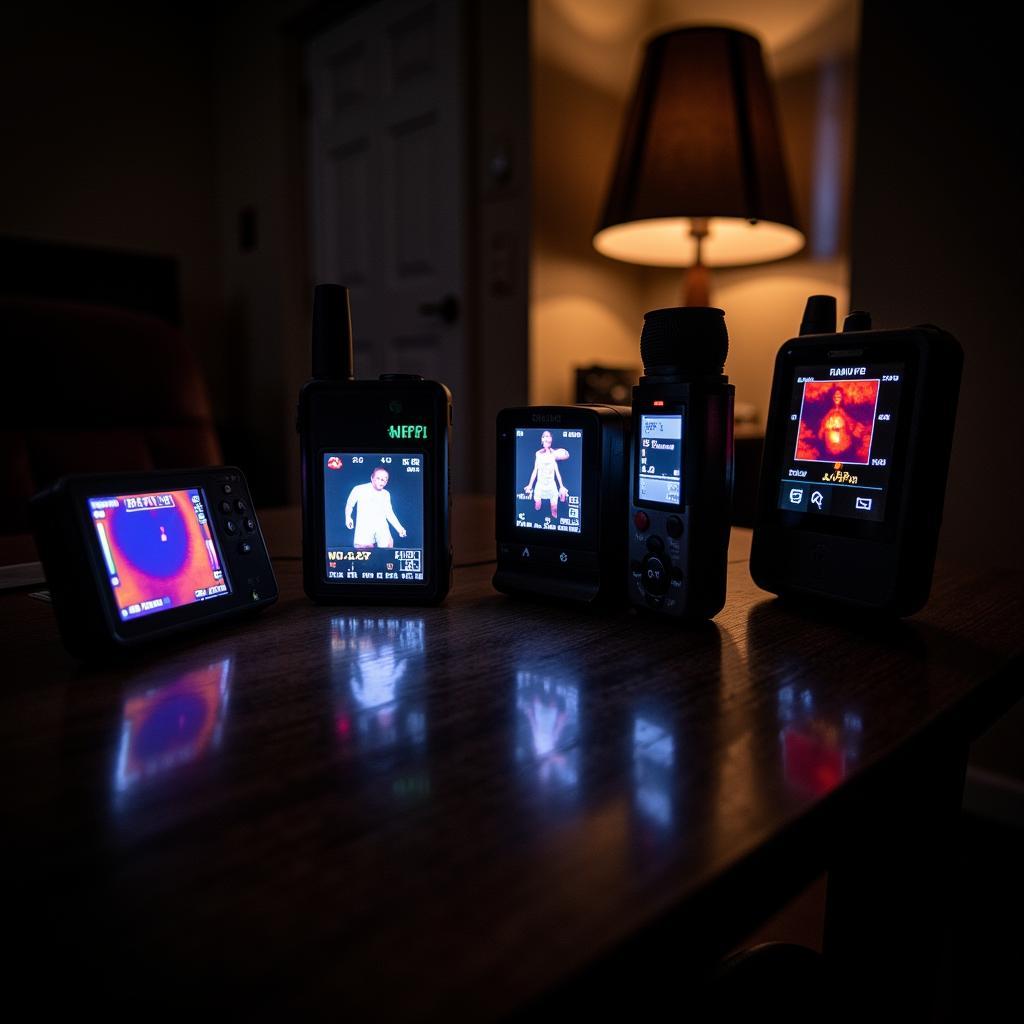Anthropological Research Methods, often associated with studying diverse cultures and societies, hold immense value in the realm of paranormal research. These methods provide a structured framework for investigating unexplained phenomena, separating genuine anomalies from misinterpretations and hoaxes. By applying rigorous observation, data collection, and analysis techniques, we can approach the supernatural with a critical lens, seeking evidence-based explanations for the seemingly inexplicable.
Bridging Anthropology and the Paranormal: Why These Methods Matter
While seemingly disparate fields, anthropology and paranormal research share a common goal: understanding the human experience. Anthropology seeks to unravel the complexities of human behavior, beliefs, and social structures, while paranormal research aims to comprehend experiences that challenge conventional understandings of reality.
 Paranormal Investigation Tools
Paranormal Investigation Tools
By employing anthropological research methods, paranormal investigators can:
- Establish a Systematic Approach: Methods like participant observation and ethnographic interviews provide a structured framework for investigating paranormal claims, ensuring consistency and reducing bias.
- Contextualize Experiences: Understanding the cultural, historical, and social context of paranormal encounters is crucial for interpreting their meaning and significance.
- Identify Patterns and Anomalies: Analyzing data collected through surveys, interviews, and archival research can reveal patterns in paranormal activity, potentially leading to new insights.
Key Anthropological Research Methods in Paranormal Investigation
Several anthropological research methods prove particularly valuable when venturing into the enigmatic world of the paranormal:
1. Ethnographic Interviews: Voices from the Unknown
Ethnographic interviews involve in-depth conversations with individuals who have experienced or witnessed paranormal phenomena. These interviews aim to gather detailed narratives, personal interpretations, and cultural beliefs surrounding the event. By allowing witnesses to share their stories openly, researchers can gain invaluable firsthand perspectives.
2. Participant Observation: Immersing in the Paranormal
Participant observation involves researchers actively immersing themselves in the environment or community where paranormal activity is reported. This could involve spending time in allegedly haunted locations, attending séances, or participating in ghost hunts. By directly observing and interacting with individuals and the environment, researchers can gather firsthand data and contextualize the experiences within their specific setting.
3. Archival Research: Unearthing the Past
Delving into historical records, local folklore, and previous paranormal investigations can provide valuable context and potential leads. Old newspapers, diaries, photographs, and even architectural plans can offer clues about past events or beliefs associated with a particular location or phenomenon.
4. Comparative Analysis: Seeking Patterns in the Unknown
Comparing and contrasting different paranormal accounts, cultural beliefs, and historical interpretations can help identify common themes, patterns, and variations. This comparative approach allows researchers to discern whether certain experiences are culturally specific or potentially indicative of a broader phenomenon.
Ethical Considerations: Navigating Sensitivity and Respect
When applying anthropological research methods to the paranormal, ethical considerations are paramount. Researchers must prioritize the well-being and respect the beliefs of individuals involved:
- Informed Consent: Obtaining informed consent from individuals participating in interviews or observations is essential, ensuring they understand the research’s purpose and their right to withdraw at any time.
- Confidentiality: Protecting the identities and personal information of participants is crucial, especially when dealing with sensitive topics that may carry social stigma.
- Sensitivity: Approaching paranormal beliefs and experiences with sensitivity and respect is vital, acknowledging that individuals’ beliefs and experiences are valid to them, even if they challenge conventional explanations.
Conclusion: Embracing Critical Inquiry in the Realm of the Unexplained
Anthropological research methods provide a valuable toolkit for exploring the unexplained, offering a structured and ethical approach to investigating paranormal claims. By employing these methods, we can move beyond mere speculation and strive for a deeper understanding of the human experience, even in its most enigmatic forms.
If you’re seeking further insights into the world of paranormal research and the application of anthropological approaches, consider exploring our articles on cultural anthropologists do research by and ethical issues in qualitative research.
While the mysteries of the paranormal may never be fully unraveled, embracing critical inquiry and rigorous research methods brings us closer to separating fact from fiction, illuminating the shadowy corners of our world.
FAQ
1. Can anthropological research methods definitively prove or disprove the existence of ghosts?
While these methods can provide valuable insights and evidence, definitively proving or disproving the existence of ghosts remains a complex challenge. However, by applying these methods, we can approach claims with a critical and evidence-based perspective.
2. How can I apply these methods to my own paranormal investigations?
Consider joining a local paranormal research group or seeking guidance from experienced researchers. Familiarize yourself with ethical guidelines and practice respectful communication when interviewing witnesses or investigating claims.
3. Are there any online resources available for learning more about anthropological research methods?
Yes, numerous universities and research institutions offer online courses and resources on qualitative research methods, including ethnographic interviews and participant observation.
4. How can I differentiate between genuine paranormal experiences and cultural interpretations?
Context is key. Understanding local beliefs, folklore, and historical narratives surrounding a particular phenomenon is crucial for discerning cultural interpretations from potentially anomalous events.
5. Can anthropological research methods be used to investigate other unexplained phenomena like UFO sightings or cryptids?
Absolutely! The principles of systematic observation, data collection, and analysis are applicable to various unexplained phenomena. By adapting these methods to different contexts, we can strive for a more nuanced understanding of the unknown.
For further assistance or information, don’t hesitate to contact us:
Phone: 0904826292
Email: research@gmail.com
Address: No. 31, Alley 142/7, P. Phú Viên, Bồ Đề, Long Biên, Hà Nội, Việt Nam.
Our dedicated team is available 24/7 to address your inquiries and provide support in your Paranormal Research endeavors.